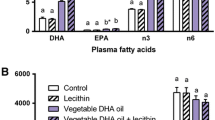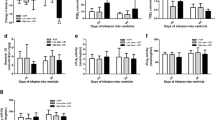Abstract
Arachidonic acid (AA), an n−6 long-chain polyunsaturated fatty acid (LC-PUFA), serves an important role in the body as a structural fatty acid of many tissues including neurological tissues. It is also a precursor of the n−6 class of eicosanoids and is the most abundant n−6 LC-PUFA found in human breast milk. We have optimized the production of a microfungal source of a triglyceride oil (ARASCO®) which is enriched in AA to about 40% by weight. To establish the safety of this oil as a food, we evaluated the effect of ARASCO® in Sprague-Dawley rats (20/sex/group) gavaged at dose levels of 1.0 and 2.5 g/kg/d for a period of 90 d, paying special attention to any potential neurotoxicity of the oil. Two groups of control animals received either untreated standard laboratory diet (untreated control) or the same diet and vehicle oil at the same dose volume administered to the treated animals (vehicle control). Physical observations, ophthalmoscopic examinations, body weight, food consumption, clinical chemistry, hematology parameters, neurobehavioral assessments, and macroscopic as well as microscopic postmortem evaluations were performed. Tissue fatty acid analyses indicated that the AA levels in the brain, heart, and liver of the high-dose ARASCO®-fed animals increased by 8, 59, and 76%, respectively, indicating that the AA in the oil was readily incorporated into tissue lipids. In spite of this high elevation in tissue AA levels, no developmental, histopathological, or neuropathological differences were seen in the animals administered ARASCO® compared with the vehicle control animals. Being highly enriched in AA, ARASCO® offers the means to study the effect of this fatty acid in experimental settings and in human metabolic studies.
Similar content being viewed by others
Abbreviations
- AA:
-
arachidonic acid
- ALA:
-
α-linolenic acid
- APPT:
-
activated partial thromboplastin time
- ARASCO® :
-
arachidonic acid single cell oil
- DHA:
-
docosahexaenoic acid
- EPA:
-
eicosapentaenoic acid
- FDA:
-
Food and Drug Administration
- LA:
-
linoleic acid
- LC-PUFA:
-
long-chain polyunsaturated fatty acid
References
Johnson, S.B., Gordon, E., McClain, C., Low, G., and Holman, R.T. (1985) Abnormal Polyunsaturated Fatty Acid Patterns of Serum Lipids in Alcoholism and Cirrhosis: Arachidonic Acid Deficiency in Cirrhosis, Proc. Natl. Acad. Sci. USA 82, 1815–1818.
Peet, M., and Laugharne, J.D.E. (1994) Arachidonic Acid: A Common Link in the Biology of Schizophrenia, Arch. Gen. Psychiatry 51, 665–666.
Holman, R.T., Johnson, S.B., and Kokmen, E. (1989) Deficiencies of Polyunsaturated Fatty Acids and Replacement by Nonessential Fatty Acids in Plasma Lipids in Multiple Sclerosis, Proc. Natl. Acad. Sci. USA 86, 4720–4724.
Hibbeln, J.R., and Salem, N., Jr. (1995) Dietary Polyunsaturated Fatty Acids and Depression: When Cholesterol Does Not Satisfy, Am. J. Clin. Nutr. 62, 1–9.
Vaddadi, K.S., Courtney, P., Gilleard, C.J., Manku, M.S., and Horrobin, D.F. (1989) A Double-Blind Trial of Essential Fatty Acid Supplementation in Patients with Tardive Dyskinesia, Psych. Res. 27, 313–323.
Lands, W.E.M. (1986) Foods, Drugs, and Disease Mechanisms, in Fish and Human Health (Lands, W.E.M., ed.) pp. 15–19, Academic Press, New York.
Carlson, S.E. (1989) Polyunsaturated Fatty Acids and Infant Nutrition, in Dietary Omega-3 and Omega-6 Fatty Acids (Galli, C., and Simopoulis, A.P., eds.) pp. 147–157, Plenum Press, New York.
Carlson, S.E., Cooke, R.J., Werkman, S.H., and Tolley, E.A. (1992) First-Year Growth of Preterm Infants Fed Standard Compared to Marine Oil n-3 Supplemented Formula, Lipids 27, 901–907.
Carlson, S.E. (1996) Arachidonic Acid Status of Human Infants: Influence of Gestational Age at Birth and Diets with Very Long Chain n-3 and n-6 Fatty Acids. J. Nutr. 126, 1092S-1098S.
Jensen, C.L., Chen, H.M., Prager, T.C., Anderson, R.E., and Heird, W.C. (1995) Effect of 18∶3n-3 Intake on Plasma Fatty Acids, Growth and Visual Development of Preterm Infants, Ped. Research 37, 311A.
Jensen, C.L., Chen, H., Fraley, J.K., Anderson, R.E., and Heird, W.C. (1996) Biochemical Effects of Dietary Linoleic/α-Linolenic Acid Ratio in Term Infants, Lipids 31, 107–113.
British Nutrition Foundation (1992) Recommendation for Intakes of Unsaturated Fatty Acids, in Unsaturated Fatty Acids: Nutritional and Physiological Significance, pp. 152–163, Chapman and Hull, London.
FAO/WHO Expert Committee (1994) Fats and Oils in Human Nutrition, Food and Nutrition Paper, No. 57, FAO, Rome.
ISSFAL Board of Directors (1994) Recommendations for the Essential Fatty Acid Requirement for Infant Formulae, ISSFAL Newsletter 1, 4–5.
Kyle, D.J. (1994) Microbial Oil Mixtures and Uses Thereof, U.S. Patent 5,374,657.
Boswell, K., Koskelo, E.K., Carl, L., Glaza, S., Hensen, D.J., Williams, K.D., and Kyle, D.J. (1996) The Preclinical Evaluation of Single-Cell Oils Which Are Highly Enriched in Arachidonic Acid and Docosahexaenoic Acid, Food Chem. Toxicol. 34, 585–593.
U.S. Food and Drug Administration Bureau of Foods (1982) Toxicological Principles for the Safety Assessment of Direct Food Additives and Color Additives Used in Food, PB83-170696, pp. 102–112.
Muggli, R. (1989) Dietary Fish Oils Increase the Requirement for Vitamin E in Humans, in Health Effects of Fish and Fish Oils (Chandra, R.K., ed.), pp. 201–210, ARTS Biomedical Publishers & Distributors, Newforundland.
Dolecek, T.A. (1992) Epidemiological Evidence of Relationships between Dietary Polyunsaturated Fatty Acids and Mortality in the Multiple-Risk Factor Intervention Trial, Proc. Soc. Exp. Biol. Med. 200, 177–182.
Seyberth, H.W., Oelz, O., Kennedy, T., Sweetman B.J., Danon, A., Frolich, J.C., Heimberg, M., and Oates, J.A. (1975) Increased Arachidonate in Lipids After Administration to Man: Effects on Prostaglandin Biosynthesis, Clin. Pharmacol. Ther. 18, 521–529.
Hendrickx, A.G., and Binkerd, P.E. (1990) Nonhuman Primates and Teratological Research, J. Med. Primatol. 19, 81–108
Wachtler, P., Koller, M., Arnold R., and Konig, W. (1995) Arachidonic Acid Induces Apoptosis in Human Polymorphonuclear Neutrophil Granulocytes, FASEB J. 9, A1041.
Ferretti, A., Nelson, G.J., Schmidt, P.C., Kelley, D.S., Bartolini, G.B., and Flanagan, V.P. (1997) Increased Dietary Arachidonic Acid Enhances the Synthesis of Vasoactive Eicosanoids in Humans, Lipids 32, 435–439.
Nelson G.J., Schmidt, P.C., Bartolini, G., Kelley, D.S., and Kyle, D. (1997) The Effect of Dietary Arachidonic Acid on Platelet Function, Platelet Fatty Acid Composition, and Blood Coagulation in Humans, Lipids 32, 421–425.
Nelson, G.J., Kelley, D.S., Emken, E.A., Phinney, S.D., Kyle, D., and Ferretti, A. (1997) A Human Dietary Arachidonic Acid Supplementation Study Conducted in a Metabolic Research Unit: Rationale and Design, Lipids 32, 415–420.
Nelson, G.J., Schmidt, P.C., Bartolini, G., Kelley, D.S., Phinney, S.D., Kyle, D., Silbermann, S., and Schaefer, E.J. (1997) The Effect of Dietary Arachidonic Acid on Plasma Lipoprotein Distributions, Apoproteins, Blood Lipid, Levels, and Tissue Fatty Acid Composition in Humans, Lipids 32, 427–433.
Emken E.A., Adlof R.O., Duval, S.M., and Nelson, G.J. (1997) Influence of Dietary Arachidonic Acid on Metabolism in vivo of 8c, 11c, 14-Eicosatrienoic Acid in Humans Lipids 32, 441–448.
Holmberg, L., and Nilsson, I.M. (1981) Assessment of Blood Coagulation and General Haemostasis, in Haemostasis and Thrombosis (Bloom, A.L., and Thomas, P.T., eds.) pp. 768–769, Churchill Livingstone, Edinburg, London Melbourne and New York.
Innis S.M., and Hansen, J.W. (1996) Plasma Fatty Acid Responses, Metabolic Effects, and Safety of Microalgal and Fungal Oils Rich in Arachidonic and Docosahexaenoic Acids in Healthy Adults, Am. J. Clin. Nutr. 64, 159–167.
Craig-Schmidt, M.C., Stieh, K.E., and Lien, E.L. (1996) Retinal Fatty Acids of Piglets Fed Docosahexaenoic and Arachidonic Acids from Microbial Sources, Lipids 31, 53–59.
Wainwright, P.E., Xing X-C., Mutsaers, L., McCutcheon D., and Kyle, D. (1996) Arachidonic Acid Offsets the Effects on Mouse Brain and Behavior of a Diet with a Low (n-6):(n-3) Ratio and Very High Levels of Docosahexaenoic Acid. J. Nutr. 127, 184–193.
Whelan, J., Broughton, K.S., Surette, M.E., and Kinsella, J.E. (1992) Dietary Arachidonic and Linoleic Acids: Comparative Effects on Tissue Lipids, Lipids 27, 85–88.
Li, B., Bridwell, C., and Whelan, J. (1994) Antithetic Relationship of Dietary Arachidonic Acid and Eicosapentaenoic Acid on Eicosanoid Production in vivo, J. Lipid Res. 35, 1869–1877.
Sanigorski A.J., O’Dea, K., and Sinclair, A.J. (1994) n-3 Fatty Acids Reduce in vitro Thromboxane Production While Having Little Effect on in vitro Prostacyclin Production in the Rat, Prostaglandins, Leukotrienes Essent. Fat Acids 50, 223–228.
Author information
Authors and Affiliations
About this article
Cite this article
Koskelo, E.K., Boswell, K., Carl, L. et al. High levels of dietary arachidonic acid triglyceride exhibit no subchronic toxicity in rats. Lipids 32, 397–405 (1997). https://doi.org/10.1007/s11745-997-0051-y
Received:
Revised:
Accepted:
Issue Date:
DOI: https://doi.org/10.1007/s11745-997-0051-y




